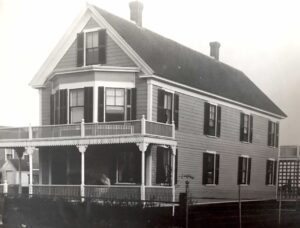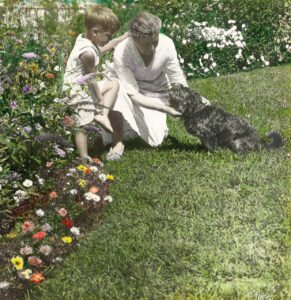While admiring April’s Super Pink Moon – and contemplating what the man up there must be thinking as he looks down on Earth’s current woes – the notion of the slingshot effect popped into my head. As someone who, as a kid, took great fascination in the Apollo program, I remember this term being used, described as a maneuver using gravity to change the speed or direction of the spacecraft. That’s as far as I will venture into the science of it, lest I earn the ridicule of all the scientists out there, but the term seemed an apt metaphor for my latest genealogical wanderings. We’ve all had those moments. We are on our way somewhere and then, in a sudden shift in trajectory, we are flung in another direction.
I’ve been spending time trying to break down a few brick walls in my great-grandmother Sadie’s maternal line (Stewart and Low), though I’m not having any success doing so. I’ve made very good progress with her paternal Lee ancestry, getting all the way back to the Great Migration on many lines, but with the exception of my great-grandmother’s maternal Gray/Getchell line (Esther Gray married Charles Stewart), I seem to be firmly stuck when it comes to learning more about Charles Stewart (1767-1832) or Charles Low (1767-1841), who married Betsy Hutchins (1771-1863). Convinced that there is a missed clue about her ancestors tucked away in one of my many files, I dug some of them out from the attic.
[Those] spaces high above daily household traffic that serve as repositories of our histories, unused items of sentimental and maybe practical value...
My “attic” isn’t really the classic front to back space under the roof since I don’t have the full extra half-story to accommodate an attic; it is better described as a space under the dormer. I call it an attic but it is really the eaves off a bedroom. It allows me easy access to files and papers that I frequently refer to, but it keeps them out of the way. My attic doesn’t have the mythology about it that real attics do, those spaces high above daily household traffic that serve as repositories of our histories, unused items of sentimental and maybe practical value from multiple generations (attics were once called lumber rooms, where unused furniture was stored), “stuff” to which we are attached, not quite ready to part with. Those spaces that become rainy day havens, where the passage of time is palpable, where memories (Remember this? or I can’t believe we saved that!) become more vivid the more we root around.
Caught in its gravitational pull, one file “sling-shotted” me away from my Stewart and Low brick walls. Handed off to me by my father some years ago, it held small family treasures: greeting cards, photographs, newspaper clippings, and what I consider the best of all the gifts, a story handwritten by my great-grandmother that she titled “A Cape Cod Attic.” There I was rooting around my “attic” only to be invited into hers.
I first read the story some years ago, when my aunt had sent it to my father with a note attached: “Dear Johnny, I found this very touching. She always did make attics magic. Love Nanny.” My aunt had added a few reference notes on the back, no doubt to help future generations sort things out. Her final notation was to identify Sadie as “my grandmother, a very dear old soul.”
The attic about which Sadie wrote was in the family summer house in Provincetown. The house, now the rectory of St. Mary of the Harbor Church, had originally belonged to my great-great-grandparents, Isaiah and Thannie (Baker) Whorf. Upon their passing, it was left to their son, my great-grandfather, Harry C. Whorf, an only child. Not only had my father, as a young boy, whiled away hours in the attic on rainy summer days, but his father, my grandfather, a painter, had made the attic the subject of numerous paintings. For my great-uncle, Richard, an actor and director, the attic was an early stage and “canvas” for his set designs.
It seems that on the day Sadie wrote her story, they were hunkered down against a fall nor’easter. And how better to spend that confinement than by remembering? I’ll let her tell you about her day.
* * *
A Cape Cod Attic
The proverbial attic, celebrated in song and story, is supposed to be the abiding place of dying poets and also starving painters. In romance it often proves to be the stronghold of forgotten treasures; but the attic of which I speak is neither of these, it is neither glamorous nor romantic. It is a Cape Cod attic, perched high above a stretch of lawn and a sandy beach and it overlooks the cold, sparkling waters of Massachusetts Bay.
However, it is spacious, and upon a sunny day it is as attractive to me as is a playground to a child. One of its windows looks down upon the rooftops across the street and into the flower garden without which no Cape Cod cottage is complete. The flowers are the brilliant trophy of early fall – hollyhock, asters, marigold and dahlias – for summer is past and no longer are countless feet pattering back and forth from the far away center of the town.
The strangely attired persons known locally as “artistes” have either packed off to happier climes, or else donned garb that neither attracts or repels, at least looking down from the dizzy height of two stories and a half. I cannot see a single one – so summer is really over.
The shutters with their tiny pierced loop-holes are closed against the “nor’easter”...
Only the ocean, just now mildly stormy, greets the eye from the opposite window. How many eyes, before my time, have looked through this pane of glass, searching as far as eye can reach for the boat that may never return? I do not know. It is a thought that makes the place seem sacred, at least while the thought lingers in my mind. The shutters with their tiny pierced loop-holes are closed against the “nor’easter” and I have no loved one far out upon the water to watch for and worry about. I turn away and look about the long, clean, unfinished room with more satisfaction than have other wives before my time. Here are trunks that it has been my part to fill with books and clothes that belonged to one who has passed on to her heavenly home.[1] I think how her tidy soul would rejoice in the knowledge that there are no “cluttering rollocks”[2] stored away in her attic, and this is not because of my handiwork, but because her son’s love of order rather than any achievement of mine. Here are her grandchildren’s toys, mostly boats, stowed away until another vacation returns and they come back to the Cape to live. Seven boats I count, some that twenty years ago belonged to their father. Well, time flies, and one generation takes up the toys, as well as the cares, that a preceding generation lays down so why worry.
Books galore are here, too, in roughly built shelves. Take a look at them and you won’t have to guess to what denomination of worship this family turned in their religious devotions. Someone I well knew loved to sing, and here are hymn-books, many of them from the old Continental Books down to the more modern S.S. Gospel Hymns[3] – “I’ve reached the land of corn and wine, And all its riches freely mine; Here shines undimmed one blissful day, For all my night has passed away.”[4] Voices from the better land come to me as I turn the pages. I have no doubt that this is true, their “night has [truly] passed away.” Though their earthly remains lie upon the hillside in the old cemetery their souls are free.[5]
The awnings, so long our joy and despair, are at last hanging here in majestic symmetry safe, I hope, from rats and mice! They seem to have the dignity of a modern stage set just waiting for the actors’ entrance. Beneath them well swept and clean stretches a length of regal, red carpet, worn to be sure, but still brave and elegant. It but enhances the stage effect. There is an actor[6] among the sons of this house, but there is naught of him up here, except three pairs of discarded shoes, standing in a very straight line upon a box under the eaves. They are good shoes and I ought to give them away, but I think of him who has so lately worn them and I shall have to wait until I miss him less! Another year and he’ll be here again with more shoes, no doubt, then I’ll give these to some boy who will be pleased to wear my boy’s shoes. He has been a pal of these Portuguese boys since he was a very small boy, coming here summer after summer and bringing with him such ideas of make-believe, such joy and fun that to his pals he is nothing less than a Hero!
[There] is naught of him up here, except three pairs of discarded shoes, standing in a very straight line upon a box under the eaves.
Here is a box of silken scraps which have been picked over and over until now, the once beautiful galaxy is but a collection of drab and dun-colored odds and ends. They smell musty for the box is seldom opened. Someday, I promise, I shall have a spasmodic dumping day and these will go! A box of red, white and blue bunting, cut into pennants and sewn upon yards and yards of tape are here. Several times since they served as decoration in a great World War pageant they have served to enhance the austere outline of this summer home on the Fourth of July. With horns tooting and flags flying from the brave little parade passing by, these red, white and blue streamers have fairly shouted “My country ‘tis of thee” to the tune of the marching band. No “reds” have ever lived under this roof and, God willing, there will never be any to decry the laws of our land!
Here, at long last, are a few antiques, a Boston rocker, a solid mahogany chair upholstered with haircloth,[7] a part of grandmother’s best parlor set, a small table of later make, brass and onyx inlaid, delicate and finicky. No one wants it. A “stand” of finished oak, a child’s rocker, a motto worked in wool, “God Bless Our Home,” it reads, and though we are storm-bound and anxious for fair weather so we may make the journey to our own home, I echo this sentiment that years ago was so happily wrought in shaded red worsted that has, like myself, found rest in this Cape Cod attic.
* * *
How many of us, now sling-shotted in an unexpected direction during our own home confinement, anxious for our own fair weather, have been rummaging around in our literal and figurative attics, washed over by memories and, perhaps, having made a discovery or found an answer we’ve long been searching for.
Notes
[1] Thannie Baker Whorf (1844-1922).
[2] Old clothes or rags.
[3] Gospel Hymns and Sacred Songs, edited by Ira D. Sankey.
[4] Beulah Land (1876) by Edgar Page Stites, popular in the Methodist Church.
[5] Hamilton Cemetery, Provincetown.
[6] Richard Whorf (1906-1966).
[7] Haircloth was a strong fabric made from horses’ tails and manes. Its sheen emulated the richness of silk and was popular with middle and upper middle-class families.
Share this:

About Amy Whorf McGuiggan
Amy Whorf McGuiggan recently published Finding Emma: My Search For the Family My Grandfather Never Knew; she is also the author of My Provincetown: Memories of a Cape Cod Childhood; Christmas in New England; and Take Me Out to the Ball Game: The Story of the Sensational Baseball Song. Past projects have included curating, researching, and writing the exhibition Forgotten Port: Provincetown’s Whaling Heritage (for the Pilgrim Monument and Provincetown Museum) and Albert Edel: Moments in Time, Pictures of Place (for the Provincetown Art Association and Museum).View all posts by Amy Whorf McGuiggan →

